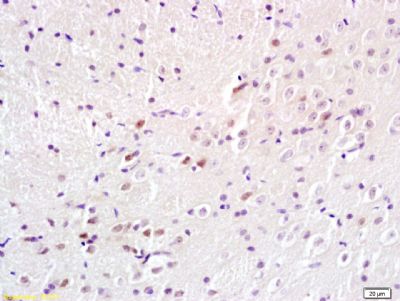BS69 Polyclonal Antibody
Purified Rabbit Polyclonal Antibody (Pab)
- SPECIFICATION
- CITATIONS
- PROTOCOLS
- BACKGROUND

Application
| IHC-P, IHC-F, IF, E |
|---|---|
| Primary Accession | Q15326 |
| Reactivity | Rat, Dog |
| Host | Rabbit |
| Clonality | Polyclonal |
| Calculated MW | 71 KDa |
| Physical State | Liquid |
| Immunogen | KLH conjugated synthetic peptide derived from human ZMYND11/BS69 |
| Epitope Specificity | 501-602/602 |
| Isotype | IgG |
| Purity | affinity purified by Protein A |
| Buffer | 0.01M TBS (pH7.4) with 1% BSA, 0.02% Proclin300 and 50% Glycerol. |
| SUBCELLULAR LOCATION | Nucleus. Chromosome. Note=Associates with chromatin and mitotic chromosomes. |
| SIMILARITY | Contains 1 bromo domain. Contains 1 MYND-type zinc finger. Contains 1 PHD-type zinc finger. Contains 1 PWWP domain. |
| SUBUNIT | Interacts (via MYND-type zinc finger) with NCOR1. Interacts (via MYND-type zinc finger) with human adenovirus early E1A protein (via PXLXP motif); this interaction inhibits E1A mediated transactivation. Interacts (via MYND-type zinc finger) with Epstein-Barr virus EBNA2 protein (via PXLXP motif). Interacts (via MYND-type zinc finger) with EZH2. Interacts with E2F6. |
| Post-translational modifications | Phosphorylated upon DNA damage, probably by ATM or ATR. Ubiquitinated, leading to proteasomal degradation. |
| Important Note | This product as supplied is intended for research use only, not for use in human, therapeutic or diagnostic applications. |
| Background Descriptions | The protein encoded by this gene was first identified by its ability to bind the adenovirus E1A protein. The protein localizes to the nucleus. It functions as a transcriptional repressor, and expression of E1A inhibits this repression. Alternatively spliced transcript variants encoding different isoforms have been identified. [provided by RefSeq, Jul 2008] |
| Gene ID | 10771 |
|---|---|
| Other Names | Zinc finger MYND domain-containing protein 11, Adenovirus 5 E1A-binding protein, Bone morphogenetic protein receptor-associated molecule 1, Protein BS69, ZMYND11 (HGNC:16966) |
| Target/Specificity | Ubiquitous. |
| Dilution | IHC-P=1:100-500,IHC-F=1:100-500,IF=1:100-500,ELISA=1:5000-10000 |
| Storage | Store at -20 ℃ for one year. Avoid repeated freeze/thaw cycles. When reconstituted in sterile pH 7.4 0.01M PBS or diluent of antibody the antibody is stable for at least two weeks at 2-4 ℃. |
| Name | ZMYND11 (HGNC:16966) |
|---|---|
| Function | Chromatin reader that specifically recognizes and binds histone H3.3 trimethylated at 'Lys-36' (H3.3K36me3) and regulates RNA polymerase II elongation. Does not bind other histone H3 subtypes (H3.1 or H3.2) (By similarity). Colocalizes with highly expressed genes and functions as a transcription corepressor by modulating RNA polymerase II at the elongation stage. Binds non-specifically to dsDNA (PubMed:24675531). Acts as a tumor-suppressor by repressing a transcriptional program essential for tumor cell growth. |
| Cellular Location | Nucleus. Chromosome Note=Associates with chromatin and mitotic chromosomes |
| Tissue Location | Ubiquitous.. |

Thousands of laboratories across the world have published research that depended on the performance of antibodies from Abcepta to advance their research. Check out links to articles that cite our products in major peer-reviewed journals, organized by research category.
info@abcepta.com, and receive a free "I Love Antibodies" mug.
Provided below are standard protocols that you may find useful for product applications.
If you have used an Abcepta product and would like to share how it has performed, please click on the "Submit Review" button and provide the requested information. Our staff will examine and post your review and contact you if needed.
If you have any additional inquiries please email technical services at tech@abcepta.com.













 Foundational characteristics of cancer include proliferation, angiogenesis, migration, evasion of apoptosis, and cellular immortality. Find key markers for these cellular processes and antibodies to detect them.
Foundational characteristics of cancer include proliferation, angiogenesis, migration, evasion of apoptosis, and cellular immortality. Find key markers for these cellular processes and antibodies to detect them. The SUMOplot™ Analysis Program predicts and scores sumoylation sites in your protein. SUMOylation is a post-translational modification involved in various cellular processes, such as nuclear-cytosolic transport, transcriptional regulation, apoptosis, protein stability, response to stress, and progression through the cell cycle.
The SUMOplot™ Analysis Program predicts and scores sumoylation sites in your protein. SUMOylation is a post-translational modification involved in various cellular processes, such as nuclear-cytosolic transport, transcriptional regulation, apoptosis, protein stability, response to stress, and progression through the cell cycle. The Autophagy Receptor Motif Plotter predicts and scores autophagy receptor binding sites in your protein. Identifying proteins connected to this pathway is critical to understanding the role of autophagy in physiological as well as pathological processes such as development, differentiation, neurodegenerative diseases, stress, infection, and cancer.
The Autophagy Receptor Motif Plotter predicts and scores autophagy receptor binding sites in your protein. Identifying proteins connected to this pathway is critical to understanding the role of autophagy in physiological as well as pathological processes such as development, differentiation, neurodegenerative diseases, stress, infection, and cancer.


